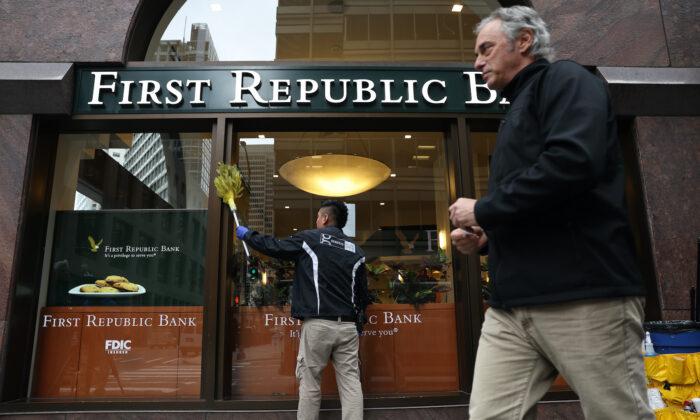The weekend brought us the news that JPMorgan Chase bought the failing First Republic Bank, with numbers that are truly mind-boggling and further shore up JPMorgan’s megabank status. For many readers, this came across as fancy high finance and nothing much to concern us, especially since the numbers are essentially incomprehensible to the regular person.
As long as the banking system as a whole remains stable, readers think all is well. And that’s exactly the messaging that the Biden administration dished out. Nothing to see here. Everyone just move on because everything is fine.
In fact, this wasn’t a normal bank merger. It was a bailout in the guise of a merger, one that massively benefits a well-heeled private interest while the public bears the cost.
Buried in the stories are two salient facts.
First, the Federal Deposit Insurance Corp. (FDIC) is financing the whole deal with $50 billion. Absent that, would the deal have gone through? Highly doubtful. Someone would have bought First Republic’s assets but at a deep discount and it likely wouldn’t have been JPMorgan.
Second, the FDIC (meaning public funds) has agreed to take on most of First Republic’s loan losses on its poorest-performing loans, which are single-family mortgages.
We’ll never know, but I would have loved to see an alternative scenario in which First Republic went on sale without the huge subsidy from the government and without the guarantee of non-performing loans. What would the price have been? How much on the dollar would the buyer have paid? Seventy cents? Twenty cents? Less? We’ll never know.
This isn’t being called a bailout because that term gives rise to memories of 2008. Instead, federal regulators have done the same thing except with a capitalistic rebrand. This is merely an acquisition just like normal capitalism! In fact, this isn’t capitalism. This is a crony deal that socializes costs and privatizes the gains.
Guess who among commentators got this exactly right and right away? It was Robert F. Kennedy Jr., who tweeted this analysis:
These are extremely astute observations and it is fascinating that he is one of the few people in public life smart enough to understand what is really going on with this fancy finance.
He also gets to the core problem: the over-financialization of the economy. This was caused by the Federal Reserve itself and its utterly insane and dangerous zero interest rate policies that kicked off in 2008. We went through 15 years of this nonsense and it created massive distortions in the production structure and the financial system generally. What’s happening right now is the Fed scrambling to cover up a problem of its own creation.
During the low-interest bacchanalia, First Republic made bank by lending to rich people for high-priced plywood palaces at extremely low rates. Everything was going along fine until the Fed realized too late that it had unleashed a terrible inflation that it had to control. So, a campaign was begun to get rates above zero, but that required an enormous and quick climb out of absurdity into reality.
The Fed can control short-term lending rates to other banks (federal funds) but it can’t control the whole yield curve. That is left to markets themselves but the Fed’s actions on the left side of the curve profoundly affect the supply and demand for loans. The entire yield structure gets repriced and that includes 30-year rates.
What this means in practice is that the bank was holding massive amounts of loans—60 percent of its portfolio—in debt priced in a way that was becoming increasingly devalued over time. No one wants to buy a bond paying 1 percent when peddlers are out there with products of the same maturity paying 6 percent. As its portfolio was being devalued, other depositors were moving money out of cash and into money markets that are now paying a nominal return in real terms.
The result for First Republic was a disastrous financial report that looked very much like Silicon Valley Bank only a month earlier. This time, the FDIC acted more quickly and seized First Republic before the dominos would continue to fall. They shopped around the assets and took some bids. JPMorgan was the best deal around, costing the FDIC only $13 billion in coverage, or so they say.
But buried in the deal and not making the headlines was $50 billion in financing costs plus the assumption of most of the bad debt held by First Republic. In other words, JPMorgan was happy to step up to put on a nice show. It meant presenting a tax-funded bailout as nothing other than a typical merger and acquisition.
What does JPMorgan get? It acquires $104 billion in deposits and $229 billion in assets, plus it gets another $50 billion from the government to make it all possible, even as it got the FDIC to assume most of the responsibility (80 percent) for bad loans buried in the bank’s portfolio.
The Wall Street Journal puts it beautifully, “There hasn’t been a more one-sided financial deal since the Dutch bought Manhattan from the Lenape Indians.”
The White House is putting the best face on it, constantly assuring the public that the problem is now contained. That is probably not true. The core problem of holding low-interest debt in a climate of rising rates affects every bank large and small. We are nowhere near knowing the full extent of the problem. As the Journal puts it, “who knows what else is lurking in the financial weeds?”
We really need to get over this idea that bank failures are somehow a terrible thing and ought to be stopped no matter what. Banks should operate like normal businesses. Their profitability and sustainability should be determined by normal standards of profit and loss, with no skewing of the game with guarantees and subsidies.
Indeed, publicly funded deposit insurance was always a mistake. It’s also a mistake for government to arrange these sweetheart deals with the biggest players that only end in centralization and perpetuation of moral hazard.
Right now, the Biden administration is rejecting market forces for fascistic-style financial maneuverings. No bank should be considered too-big-to-fail. And when these seizures occur, the assets should be put on the market to be sold as is, the same as a house in foreclosure. Anything else is a tax-funded subsidy to the richest.





